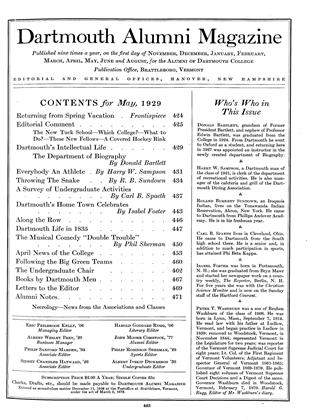You remember Andre Maurois's description of Dartmouth as the place where the students, their day's work done, withdraw to spend the night in the neighboring forests, uttering as they go cries of "ouah! ouah!" Clever travelers who write are always writing like that. They tell the truth—oh, no doubt of it, but it is truth so deftly re-arranged, so posed and illuminated, that it becomes something else. Like that bronze of Brancusi's, which, elevated on a pedestal and lit from below, was as airy and gossamer as a bird's flight, but crated and excelsiored, on the floor of the customs house, seemed just hardware and subject to 20% ad valorem. Mrs. Benson says, for instance, that when Japanese artillery comes to rest a red plush arm chair is placed behind each gun, presumably for tired officers. Who cares whether it's true? It's picturesque.
That's the business of the writer of travel—to be picturesque. A Buddhist temple in Korea is "apparently hung from the sky, or pinned lightly to the face of a precipice. It looked like a swallow clinging to the wall of a barn. . . . The priest who thus wisely stole a march on his confreres by living half-way to heaven warned us not to smoke, as the ground was holy. . . . The part of the temple he lived in was on the brink of the cliff, but the part in which Buddha lived was actually over the brink, reached by a trembling climb down a dozen crooked steps, unprotected by any rail. A little white and gold Buddha presided over a very austere small white and gold room, dimly lit by paper windows in carved wooden lattices. The priest opened a hinged shutter in the floor, and, catching our breath, we looked down into empty wind, flowing like clear water over a very distant floor of tossing red maples."
Yi, a polyglot Korean cook, "squats on his haunches on the tennis court at sunset, reading laboriously, singing gently as he reads. 'My niss-paper,' the periodical is called, and he often brings it up in conversation, quoting items from it that he thinks will interest me. 'English master called Shosh go homeside in big ship last week, my niss-paper talkee.'
" 'Really, Yi, but do I know Mr. Shosh?'
" 'Master Shosh very much big master, have got very much big house, long time ago his small baby fall out windowside, my niss-paper talkee . . . have got very much big earth-jump Japanside, my niss-paper talkee.' In order to make this graphic, he shakes the fruit we are bottling violently up and down, spilling half of it. 'America-side woman have got small child avec trois jambes, my niss-paper talkee. . . .
Except that the order of these sketches of Manchuria, Korea, China, Japan, and America, is helter skelter, and that the last one is singularly flat, this is an excellent book.
 View Full Issue
View Full Issue
More From This Issue
-
 Article
ArticleA Survey of Undergraduate Activities
May 1929 By Carl B. Spaeth -
 Class Notes
Class NotesClass of 1898
May 1929 By H. Phillip Patey -
 Lettter from the Editor
Lettter from the EditorFor opinions which appear in these columns the Editors alone are responsible
May 1929 -
 Class Notes
Class NotesClass of 1923
May 1929 By Truman T. Metzel -
 Article
ArticleDartmouth Life in 1835
May 1929 -
 Class Notes
Class NotesClass of 1910
May 1929 By Arthur P. Allen
W. B. P.
Article
-
 Article
ArticleATTENDANCE AT THE SUMMER SESSION
November 1918 -
 Article
ArticleFood for Thought
FEBRUARY, 1927 -
 Article
ArticleAdmission to V-12
June 1943 -
 Article
Article$1.04 Million
JAnuAry | FebruAry -
 Article
ArticleBIGNESS
December 1953 By DAVID E. LILIENTHAL -
 Article
ArticleCollege Comptroller Retires
OCTOBER 1966 By Robert D. Funkhouser '27






